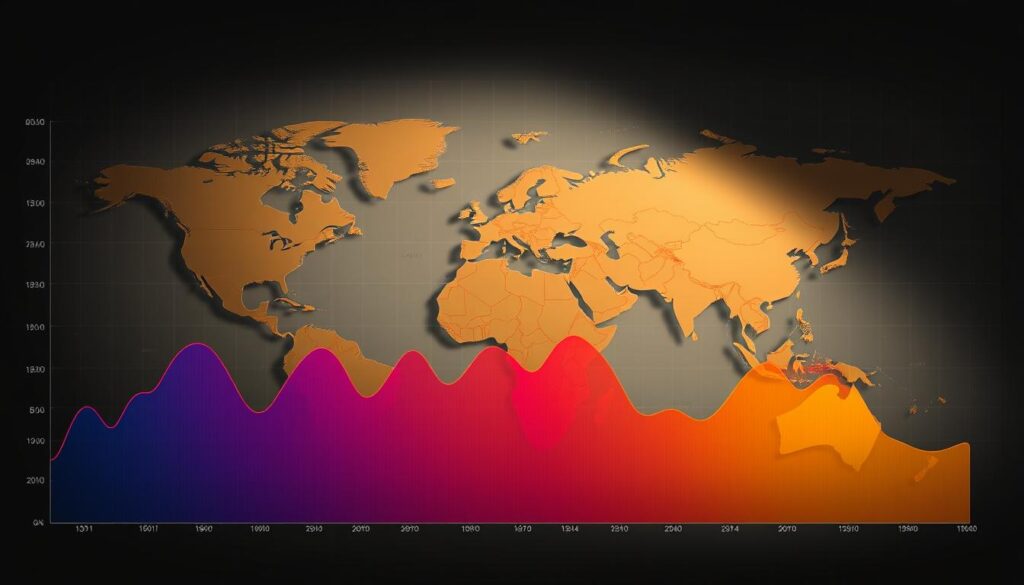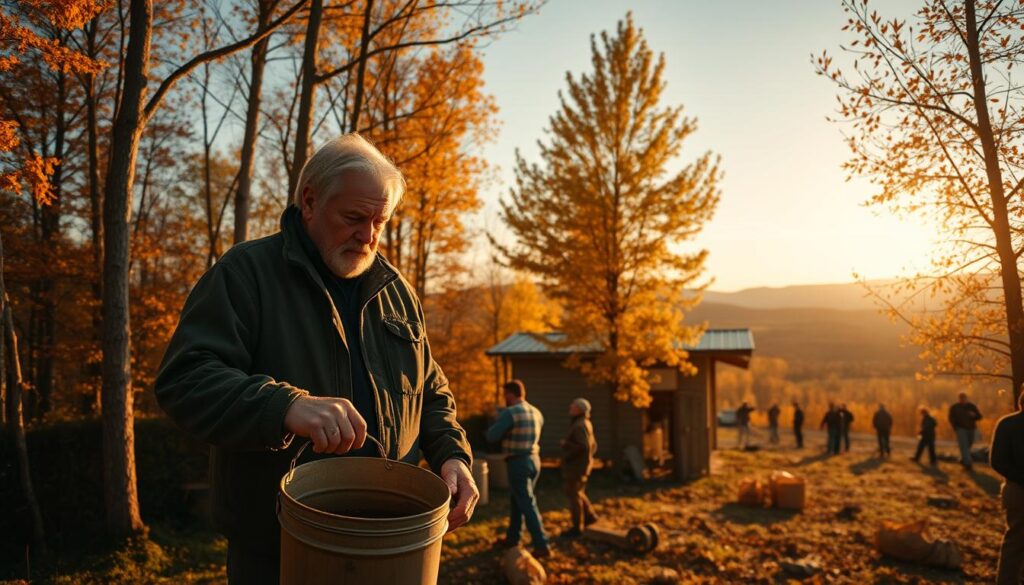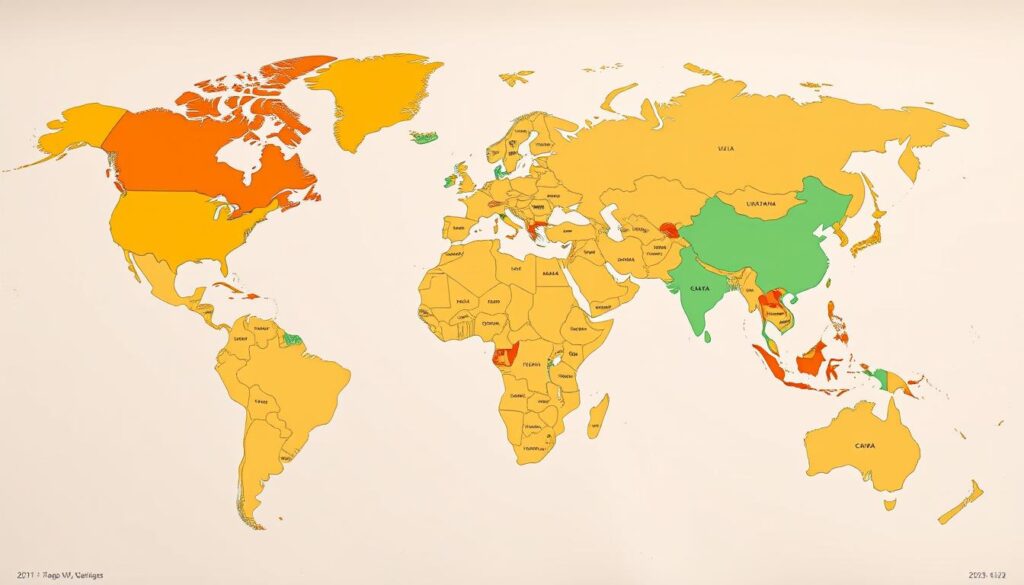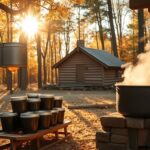Maple syrup is a unique agricultural treasure. It turns simple tree sap into a golden culinary delight. Countries with the right climate and geography lead in maple syrup production. They have turned this natural sweetener into a global product.
In the world of maple syrup, North America stands out. Canada and the United States are the big players. They have the right conditions and skills to make maple syrup.
The best producers use their northern forests. These forests are perfect for maple trees. Cold winters and mild springs make sap collection easy.
Maple syrup production is more than just farming. It’s about caring for the environment, keeping traditions alive, and using new technology. Each country adds its own touch to maple syrup, thanks to local forests and family knowledge.
For those interested in maple syrup, there’s a lot to learn. From Quebec’s vast forests to Vermont’s woodlands, there’s a story behind every bottle. This journey into maple syrup production is both fascinating and delicious.
Understanding Global Maple Syrup Production
Maple syrup production is a mix of natural science and farming skills. The best maple syrup makers have a detailed process to turn tree sap into a tasty golden liquid. This amazing process starts in the maple forests of North America. There, the right environment helps make syrup extraction possible.
The Science Behind Maple Syrup Extraction
The maple syrup production map shows a complex process. It happens in certain maple trees. In late winter and early spring, sugar maples store starch in their roots and trunks. When it gets cold at night and warm during the day, this starch turns into sugar. This is the sweet sap that sugarmakers collect.
- Trees must be at least 40 years old for tapping
- Optimal sap flow requires temperature ranges between 40-45°F
- Each tree can produce 10-20 gallons of sap per season
Optimal Climate Conditions for Production
Climate is key for making maple syrup. The best places have clear seasonal changes, mainly in northeastern North America. These areas have the right temperature changes for making top-quality maple syrup.
“Maple syrup is nature’s most perfectalchemy – transforming tree sap into liquid gold through temperature and time.” – Sugarmaker Wisdom
Production Seasons Worldwide
The maple syrup production season lasts 4-6 weeks. The exact time changes based on where you are. In the United States and Canada, it usually happens from February to April. This is when the day gets warmer but the night stays cold.
- Northeastern United States: Primary production region
- Quebec, Canada: Longest and most consistent production season
- Vermont: Significant contributor to maple syrup output
Canada: The World’s Leading Producer
Canada leads the world in maple syrup production, making up 71% of it. Quebec is at the heart of this, making most of Canada’s maple syrup.
Canada’s maple syrup is made in several provinces. This creates a strong system for making syrup. Key areas include:
- Quebec: Makes about 90% of Canada’s maple syrup
- Ontario: The second-biggest syrup producer
- New Brunswick: A big part of national production
- Nova Scotia: Starting to grow its syrup market
Canada’s maple syrup industry is well-planned. The country has over 44 million maple trees. It also has about 13,500 syrup producers. They use new tech and old ways to keep syrup quality high.
“Canada’s maple syrup production is not just an industry, it’s a cultural heritage,” says Jean Tremblay, a third-generation maple syrup producer from Quebec.
Maple syrup does more than just make money. It helps rural areas a lot. The syrup’s exports are worth $487 million a year. It shows Canada’s dedication to farming and keeping traditions alive.
Maple Syrup Production by Country: Current Statistics
The global maple syrup industry is full of interesting facts. It shows how different countries produce and sell maple syrup. This gives us a peek into this special farming area.
Maple syrup is mainly made in North America. It’s a big deal for the economy. New ways of making syrup help it grow even more.
Annual Production Volumes
Here’s what the top maple syrup makers produce each year:
- Canada: 13.2 million gallons annually
- United States: 4.5 million gallons per year
- Quebec: Approximately 10.5 million gallons
Year-over-Year Growth Trends
Maple syrup exports are going up every year. North America is leading this growth. Better farming tools and more people wanting syrup are the reasons.
Market Share Distribution
Who makes the most maple syrup? Let’s see:
- Canada controls approximately 71% of global production
- United States represents about 24% of total output
- Other regions contribute the remaining 5%
The maple syrup production ranking shows how focused the industry is. It also shows its big economic chance.
United States: Second Largest Producer

The United States is a big name in maple syrup, ranking second worldwide. Vermont is the leader, making about 47% of the U.S. maple syrup.
Recent years have seen big growth in the U.S. maple syrup industry. Small farms and family-owned businesses play a big role in this growth.
- Top maple syrup producing states:
- Vermont
- New York
- Maine
- New Hampshire
- Massachusetts
Maple syrup makers in the U.S. face challenges like climate change and Canadian imports. They’re using new tech to work better and be kinder to the environment.
| State | Annual Production (Gallons) | Percentage of U.S. Total |
|---|---|---|
| Vermont | 1.8 million | 47% |
| New York | 820,000 | 21% |
| Maine | 520,000 | 14% |
| New Hampshire | 310,000 | 8% |
| Massachusetts | 220,000 | 6% |
Technological advancements and sustainable practices are shaping the future of maple syrup production in the United States. New methods help producers get more syrup while keeping maple forests healthy.
Quebec’s Dominance in Global Production
Quebec is the top producer of maple syrup worldwide. It holds a huge 72% of global production. This makes it a key player in the maple syrup market.
Production Infrastructure
Quebec’s maple syrup setup is top-notch. It has a vast network of sugar bushes. This creates a perfect environment for maple syrup production.
- Over 7,300 maple syrup producers operate in Quebec
- Approximately 47 million taps are utilized annually
- Advanced collection and processing technologies streamline production
Strategic Reserve System
Quebec’s reserve system is a global model. The Federation of Quebec Maple Syrup Producers keeps a large stockpile. This helps keep prices stable and supply consistent.
| Year | Strategic Reserve Volume (Barrels) | Value (USD) |
|---|---|---|
| 2020 | 93,000 | $180 million |
| 2021 | 103,000 | $220 million |
| 2022 | 112,000 | $250 million |
Quality Control Measures
Quebec is strict about quality. It has high grading standards and testing. This ensures top-notch maple syrup.
- Mandatory quality inspections for all producers
- Standardized grading systems
- Genetic traceability of maple trees
Quebec shows how focus and planning can lead to global success in agriculture.
Economic Impact of Maple Syrup Industry
The maple syrup industry is a big deal for rural areas in North America. It’s more than just making food; it’s a strong economic force. Both small and big producers help boost local economies.
Here are some ways the maple syrup industry helps:
- It creates jobs in rural areas
- It supports local farming
- It brings in a lot of money from exports
- It keeps old farming ways alive
Statistics show the maple syrup industry is very strong. It makes hundreds of millions of dollars every year. Quebec alone makes about 70% of the world’s maple syrup. This creates thousands of jobs and supports a big supply chain.
The impact is felt in many areas:
- It helps make farming equipment
- It boosts transportation and logistics
- It’s used in food processing
- It helps tourism and marketing
Rural areas get a lot from maple syrup production. They get direct investments and ongoing economic activity. The industry helps small farmers and opens up trade opportunities worldwide.
“Maple syrup is not just a product, it’s an economic ecosystem that supports entire communities” – Agricultural Economic Research Institute
Production Methods and Technology Advances
The world of maple syrup production has changed a lot thanks to new technology. Sugarmakers now use advanced methods that mix old ways with new efficiency. This has changed how maple syrup is made and processed.
Today, maple syrup making uses top-notch tech to boost both amount and quality. The map of maple syrup production shows big changes in technology. These changes have greatly affected the industry.
Traditional vs Modern Techniques
Old ways of making maple syrup involved a lot of manual work and simple tools. Sugarmakers used:
- Wooden buckets for sap collection
- Wood-fired evaporation pans
- Hand-tapping maple trees
Now, they use:
- Vacuum tubing systems
- Reverse osmosis technology
- High-efficiency evaporators
Sustainability Practices
The maple syrup world focuses a lot on taking care of the environment. Modern sugarmakers use:
- Forest conservation techniques
- Energy-efficient processing methods
- Sustainable forest management
“Technology allows us to preserve tradition while improving production efficiency” – Vermont Maple Sugar Makers Association
These new tech steps have really helped increase maple syrup production worldwide. They make it possible to extract and process syrup more accurately. This keeps the true taste that maple syrup lovers enjoy.
Global Market Demand and Export Trends

The maple syrup market has grown a lot in recent years. This growth is thanks to more people wanting natural sweeteners. Maple syrup export data shows a bright future for producers everywhere, with demand rising in places beyond North America.
Market trends show a big increase in global consumption. The U.S. and European countries are now big buyers. They look for top-quality maple syrup from Canada and the U.S.
- Global maple syrup market value reached $1.5 billion in 2022
- Export volumes increased by 12% compared to previous years
- Growing popularity in health-conscious consumer segments
Places like Japan, South Korea, and China are now big buyers too. They’re showing a big interest in maple syrup. This shows more people around the world are loving this natural sweetener.
| Country | Import Volume (Metric Tons) | Market Growth Rate |
|---|---|---|
| United States | 15,200 | 8.5% |
| European Union | 7,500 | 6.2% |
| Japan | 3,800 | 10.3% |
Producers are changing to meet market trends. They’re making new packaging and premium products. Organic and artisanal maple syrups are very popular. People want real and top-quality natural sweeteners.
“The global maple syrup market represents an exciting opportunity for sustainable agricultural products.” – Canadian Maple Syrup Association
Trade deals and lower tariffs have helped maple syrup exports grow. This has opened up new chances for farmers in North America.
Environmental Factors Affecting Production
The world of maple syrup production is changing due to environmental challenges. These changes affect how maple syrup is made in different countries. Climate shifts and forest health are key to the success of maple syrup making.
Looking at the maple syrup production map shows big problems with forestry. The health of maple trees and the environment are very important. They decide if maple syrup making can keep going.
Climate Change Impact
Global warming is a big problem for maple syrup makers. It causes:
- Shorter maple sugaring seasons
- Unpredictable sap flow
- More stress on maple trees
- Less sugar in sap
Forest Management Practices
Good forest management is key to saving maple syrup production. Makers are trying new ways to keep forests healthy:
- Managing tree ages
- Using selective harvesting
- Keeping forests diverse
- Monitoring forest health
Being good stewards of the environment is the future of maple syrup making in North America.
Industry Challenges and Future Outlook

The maple syrup industry is facing big challenges that are changing how maple syrup is sold. There’s a shortage of workers and costs to make syrup are going up. Producers in North America must deal with tough economic times while keeping their syrup quality high and prices fair.
Looking at maple syrup industry statistics, we see a few big concerns:
- Declining maple forest health due to climate change
- Rising operational expenses
- Limited skilled workforce in rural production regions
- Increasing competition from synthetic sweetener markets
New technologies are bringing hope for the future. Better ways to collect sap and use precision farming are changing how syrup is made. Producers are using smart systems to tap trees and manage resources better.
| Challenge Category | Potential Impact | Mitigation Strategy |
|---|---|---|
| Environmental Stress | Reduced Maple Tree Productivity | Forest Regeneration Programs |
| Labor Constraints | Production Inefficiency | Automation and Training Initiatives |
| Market Competition | Reduced Market Share | Product Diversification |
Emerging markets in Asia present exciting opportunities for maple syrup producers. By creating new products and growing their global reach, the industry can beat current hurdles and grow in a lasting way.
Quality Standards and Grading Systems
Maple syrup production has strict quality control. This makes top maple syrup producers stand out worldwide. The grading system is key to the syrup’s value and market position globally.
The ranking of maple syrup production is based on strict quality checks. These checks look at many aspects of the syrup. This ensures that customers get a high-quality maple syrup experience every time.
International Grading Methods
Each region has its own way of grading maple syrup. The main things they look at are:
- Color intensity
- Flavor profile
- Light transmission
- Clarity
- Mineral content
Quality Control Protocols
Top maple syrup producers use advanced testing to keep their products top-notch. They do detailed sensory and lab tests.
| Grading Category | Color | Flavor Characteristics |
|---|---|---|
| Golden Delicate | Light | Mild, subtle maple essence |
| Amber Rich | Medium | Robust, pronounced maple flavor |
| Dark Robust | Dark | Strong, intense maple taste |
The maple syrup industry keeps improving its quality standards. This ensures that top producers keep their products of the highest quality. They meet the expectations of the international market.
Emerging Markets and Production Regions
The world of maple syrup production is growing. New places are trying to make maple syrup because of changes in the weather and new farming methods.
In Eastern Europe, countries like Romania and Ukraine see a chance to make maple syrup. They have lots of maple trees that could be used to make syrup. This is making the global maple syrup map more interesting.
But, these new places face big challenges:
- Building special equipment to make syrup
- Training people to make syrup
- Learning about their local forests
- Meeting quality standards from other countries
Asian countries like Japan and South Korea are also trying to make maple syrup. They use their advanced farming tech to find new ways to make syrup.
“The future of maple syrup isn’t just in North America anymore – it’s becoming a truly global industry.” – Agricultural Innovation Research Group
The chance for growth is huge. Even though Canada and the US are big in maple syrup, new places offer a chance for more variety in farming.
Conclusion
The world of Maple Syrup Production is changing fast. Canada and the United States lead the way, with Quebec being the top spot for maple syrup. New tech and green practices are changing how maple syrup is made, keeping this old tradition alive.
Maple syrup’s market is strong and growing. Producers face challenges like the weather and caring for the environment. They’re finding new ways to make this sweet treat, keeping its quality high.
The maple syrup world is set for big changes. New markets and tech are opening doors for makers. They must mix old ways with new to keep maple syrup special and loved by all.
Maple syrup is a mix of nature, farming skills, and tradition. It goes from Quebec’s forests to new places, winning hearts with its taste. It also helps local economies, showing its value and beauty.



